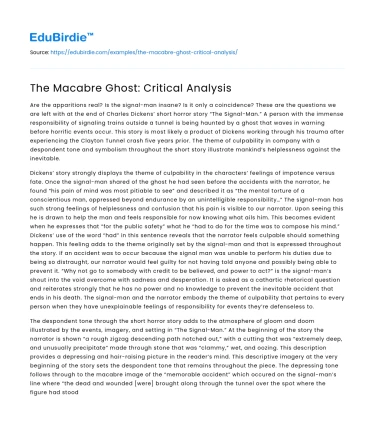Are the apparitions real? Is the signal-man insane? Is it only a coincidence? These are the questions we are left with at the end of Charles Dickens’ short horror story “The Signal-Man.” A person with the immense responsibility of signaling trains outside a tunnel is being haunted by a ghost that waves in warning before horrific events occur. This story is most likely a product of Dickens working through his trauma after experiencing the Clayton Tunnel crash five years prior. The theme of culpability in company with a despondent tone and symbolism throughout the short story illustrate mankind’s helplessness against the inevitable.
Dickens’ story strongly displays the theme of culpability in the characters’ feelings of impotence versus fate. Once the signal-man shared of the ghost he had seen before the accidents with the narrator, he found “his pain of mind was most pitiable to see” and described it as “the mental torture of a conscientious man, oppressed beyond endurance by an unintelligible responsibility…” The signal-man has such strong feelings of helplessness and confusion that his pain is visible to our narrator. Upon seeing this he is drawn to help the man and feels responsible for now knowing what ails him. This becomes evident when he expresses that “for the public safety” what he “had to do for the time was to compose his mind.” Dickens’ use of the word “had” in this sentence reveals that the narrator feels culpable should something happen. This feeling adds to the theme originally set by the signal-man and that is expressed throughout the story. If an accident was to occur because the signal man was unable to perform his duties due to being so distraught, our narrator would feel guilty for not having told anyone and possibly being able to prevent it. “Why not go to somebody with credit to be believed, and power to act?” is the signal-man’s shout into the void overcome with sadness and desperation. It is asked as a cathartic rhetorical question and reiterates strongly that he has no power and no knowledge to prevent the inevitable accident that ends in his death. The signal-man and the narrator embody the theme of culpability that pertains to every person when they have unexplainable feelings of responsibility for events they’re defenseless to.
Save your time!
We can take care of your essay
- Proper editing and formatting
- Free revision, title page, and bibliography
- Flexible prices and money-back guarantee
The despondent tone through the short horror story adds to the atmosphere of gloom and doom illustrated by the events, imagery, and setting in “The Signal-Man.” At the beginning of the story the narrator is shown “a rough zigzag descending path notched out,” with a cutting that was “extremely deep, and unusually precipitate” made through stone that was “clammy,” wet, and oozing. This description provides a depressing and hair-raising picture in the reader’s mind. This descriptive imagery at the very beginning of the story sets the despondent tone that remains throughout the piece. The depressing tone follows through to the macabre image of the “memorable accident” which occured on the signal-man’s line where “the dead and wounded [were] brought along through the tunnel over the spot where the figure had stood.” This part of the passage is as despondent as it gets. The “memorable accident” is the cherry on top of the frightening occurrences surrounding that tunnel and the signal-man in the story. Dickens most likely is referring to the Clayton Tunnel crash that happened in 1861 that he experienced first hand. Events like this are the things that make mankind feel helpless to prevent disasters, and force us to feel as though we are working against fate hopelessly.
Symbolism in “The Signal-Man” is apparent in the red danger light, the signal man, and the reappearing ghost that the signal-man sees. The red danger light exemplifies danger and warning. Red is repeatedly used as a color descriptive of death and negativity throughout literature and especially in this story. The characters stare at the light waiting multiple times in the story. The signal-man is representative of all people in life who feel helpless and unreasonably guilty after traumatic events. Everyone feels the urge to help and prevent horrific incidents from taking place, like the signal-man, but we are not always able to. The ghost he sees symbolizes the wanting that people have to warn each other and do good, but still fail to do so in the face of providence. The ghost attempts to warn the signal-man, but only in vain. It only adds to his anxiety and does nothing to prevent the accidents. The symbolism in “The Signal-Man” exemplifies my claim more effectively than anything else.
Through the use of symbolism, a despondent tone, and a theme of culpability in his short story “The Signal-Man” Charles Dickens writes a cathartic short horror story about people’s feelings of helplessness in the face of horrendous events and possibly his own feelings following the Clayton Tunnel Crash.
Did you like this example?
Make sure you submit a unique essay
Our writers will provide you with an essay sample written from scratch: any topic, any deadline, any instructions.
Cite this paper
-
APA
-
MLA
-
Harvard
-
Vancouver
The Macabre Ghost: Critical Analysis.
(2022, August 12). Edubirdie. Retrieved December 22, 2024, from https://edubirdie.com/examples/the-macabre-ghost-critical-analysis/
“The Macabre Ghost: Critical Analysis.” Edubirdie, 12 Aug. 2022, edubirdie.com/examples/the-macabre-ghost-critical-analysis/
The Macabre Ghost: Critical Analysis. [online].
Available at: <https://edubirdie.com/examples/the-macabre-ghost-critical-analysis/> [Accessed 22 Dec. 2024].
The Macabre Ghost: Critical Analysis [Internet]. Edubirdie.
2022 Aug 12 [cited 2024 Dec 22].
Available from: https://edubirdie.com/examples/the-macabre-ghost-critical-analysis/
copy






 Stuck on your essay?
Stuck on your essay?

